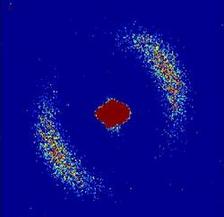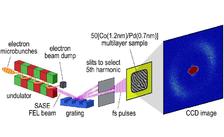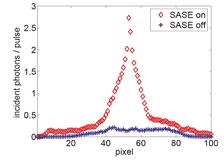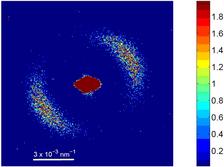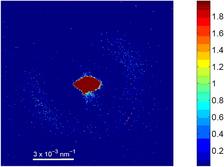Figure 1: Scheme of the experimental setup. Flashes of soft X-ray laser light are produced by self-amplified stimulated emission (SASE) in a planar undulator with a photon wavelength of λ=7.97 nm in the fundamental mode. A plane grating monochromator is used to select the fifth harmonic with λ=1.59 nm, matching the energy of the cobalt L3 edge. A resonant magnetic scattering signal from a Co/Pt multilayer sample exhibiting a magnetic domain structure is recorded on a CCD detector.
C. Gutt1, L.-M. Stadler1, S. Streit-Nierobisch1, A. Mancuso1, A. Schropp1, B. Pfau2, C.M. Günther2, R. Könnecke2, J. Gulden1, B. Reime1, J. Feldhaus1, E. Weckert1, I.A. Vartanyants1, O. Hellwig3, F. Staier4, R. Barth4, M. Grunze4, A. Rosenhahn4, D. Stickler5, H. Stillrich5, R. Frömter5, H.P. Oepen5, M. Martins6, T. Nisius7,T. Wilhein7, B. Faatz1, N. Guerassimova1, K. Honkavaara1, V. Kocharyan1, R. Treusch1, E. Saldin1, S. Schreiber1, E.A. Schneidmiller1, M.V. Yurkov1, S. Eisebitt2, and G. Grübel1
1 Deutsches Elektronen-Synchrotron DESY, Notkestraße 85, D-22607 Hamburg, Germany
2 Berliner Elektronenspeicherring BESSY - Gesellschaft für Synchrotronstrahlung, Albert-Einstein-Straße 15, D-12489 Berlin, Germany
3 Hitachi Global Storage Technology, 650 Harry Road, San Jose, CA 95120, USA
4 Institut für Physikalische Chemie, Universität Heidelberg, Im Neuenheimer Feld 229, D-69120 Heidelberg, Germany
5 Institut für Angewandte Physik, Universität Hamburg, Jungiusstraße 11, D-20355 Hamburg, Germany
6 Institut für Experimentalphysik, Universität Hamburg, Luruper Chaussee 149, D-22761 Hamburg, Germany
7 Institute for X-ray-Optics, RheinAhr-Campus Remagen, FH Koblenz, Südallee 2, D-53424 Remagen, Germany
Published as: Resonant magnetic scattering with femtosecond soft X-ray pulses from a free electron laser operating at 1.59 nm, Phys Rev B 79, 212406 (2009)
We report on a resonant magnetic scattering experiment using soft X-ray pulses generated from the free-electron laser FLASH at DESY. Using the fundamental wavelength of FLASH at 7.97 nm we were able to detect the 5th harmonic at a wavelength of 1.59 nm with an average energy of 4 nJ per pulse. We demonstrated the feasibility of resonant magnetic scattering at an FEL source by using a Co/Pd multilayer as prototype sample that was illuminated with 20 femtosecond-long soft X-ray pulses tuned to the Co L3 absorption edge at 778.1 eV (1.59nm).
The quest for smaller and faster magnetic storage devices is a formidable challenge in modern magnetism. Ideally, one would like to probe elementary magnetization dynamics such as spin-flip processes and their coupling to the electronic system on their intrinsic femtoseconds time scales [Beaurepaire1996, Stamm2007]. At the same time nanometer spatial resolution and element-specific information are required in order to account for the complex composition of technologically relevant magnetic media and devices. Simultaneous fulfilment of these requirements mandates ultrafast magnetic scattering experiments using flashes of resonantly [Gibbs1985] tuned soft X-rays, in particular for the technologically relevant transition metals Cr, Mn, Fe, Co, and Ni with 2p electron binding energies between approximately 550 and 900 eV. In the near future, such experiments can be anticipated given the current construction of X-ray free-electron lasers (FEL) in the USA, Japan, and Germany.
At present the world's most powerful FEL - FLASH in Hamburg, Germany - provides uniquely intense coherent short pulses in the extreme ultraviolet (EUV) energy range with the shortest fundamental wavelength of 6.5 nm. Evidence for lasing at higher harmonics of the fundamental mode has been reported recently [Ackermann2007] and the use of the fifth harmonic of the fundamental at 7.97 nm bring the FEL wavelength down to 1.59 nm. This wavelength has enabled us to demonstrate the feasibility of resonant magnetic scattering experiments at FEL sources.
FLASH was operated at the fundamental with an average energy per pulse of 15 µJ and 10 fs pulse duration. Self amplified spontaneous emission (SASE) soft X-ray radiation at the fifth harmonic (778.1 eV photon energy) was thus in resonance with the magnetically dichroic transitions of Co 2p3/2 electrons thus providing magnetic contrast for a scattering experiment. At the resonance energy, the fifth harmonic was detected with an average energy of about 4 nJ per pulse and a relative spectral bandwidth of 0.7- 0.9 %.
The experiment has been performed at the FLASH beamline PG2 [Martins2006] (Figure 1). A plane grating monochromator separates the fifth harmonic from the other wavelengths contained in the FEL beam. The carbon coated optical elements (optimized for FLASH fundamental wavelengths) lead to a low beamline transmission coefficient of 2.3 x 10-4 at 1.59 nm. Due to this fact, only 7 x 103 photons per pulse were available for the experiment here. Figure 2 displays line profiles through the direct beam with SASE switched on and off, showing that the average intensity of the ultrashort laser pulses exceeds the spontaneous radiation at the fifth harmonic by one order of magnitude.
Using the soft X-ray SASE photons we demonstrate resonant magnetic diffraction with a [Co(1.2nm)/Pd(0.7nm)]50 multilayer sample in transmission geometry. In multilayer samples of this composition magnetic domains with alternating up and down magnetization form with a typical spatial correlation length of the order of 200-300 nanometers. Figure 3 shows the measured magnetic scattering pattern with a pronounced small-angle signal. The observed intensity maximum at a wavevector transfer of qmax=0.033 nm-1 reflects the mean distance of 190 nm between two domains with the same orientation of the magnetic moment. This implies a domain size of about 95 nm. The diffraction pattern has been recorded within 1000 seconds and contains 6.7 x 104 scattered photons.
Detuning the photon energy away from the resonance reduces the magnetic scattering contrast. Figure 4 shows the CCD image measured with a photon energy of 783.5 eV, which is slightly off resonance. The scattered intensity has decreased considerably leading to a very weak small angle scattering ring. Taking the relatively large bandwidth of 0.7- 0.9 % into account we estimate with the help of the energy dependent magnetic scattering factors a signal reduction of a factor 4-6, which is in good agreement with the observation. However, we would like to point out that this bandwidth is sufficient to generate contrast for resonant magnetic scattering. This implies that there is no narrow bandwidth monochromator required. As a result, the beamline transmission losses could be easily reduced by two to three orders of magnitude with suitably designed optical elements.
In conclusion, we have demonstrated that the higher harmonics of the free-electron laser FLASH reach well into the soft X-ray regime, and provide access to the absorption edges of the 3d transition metals. In particular, we have demonstrated the feasibility of resonant magnetic scattering using soft X-ray laser pulses via the 5th harmonic. This opens the way for measuring element-specific magnetization dynamics on femto and picosecond timescales and on nanometer spatial length scales.
Optimized setups for soft X-ray wavelengths will lead to intensity gains of 2-3 orders of magnitude which will make optical pump and X-ray diffraction probe measurements possible at FLASH by using a single FEL pulse. The high intensities delivered on ultrafast timescales in combination with the high degree of spatial coherence of the FEL radiation will allow in the future the measurement of element specific spatial correlation functions in magnetic systems.
| References | ||||||||||
|
| Contact Information |
|
Christian Gutt |
| Further Information |





